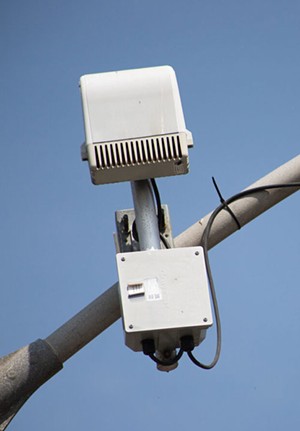During its first 18 months of use, the accuracy of an elaborate system designed to detect gunfire on Springfield's east side and central neighborhoods can be verified less than 25% of the time.
Despite this, the Springfield City Council voted to add additional layers of technology to the system on which $644,000 has already been spent.
ShotSpotter, a California-based company, created a system of microphones to detect gunfire in a 5.2-square-mile area of Springfield's east side and central neighborhoods, focusing on parts of the city where gun violence tends to occur more frequently. When gunfire is detected, it is entered into a computer system which can immediately give a precise spot where the shots were fired and feed the location to police officers patrolling the area.
At least, that's the way it is supposed to work. Springfield Police Chief Kenny Winslow said in only 23% of these calls are officers able to find collaborating evidence of gunfire such as spent shell casings, bullet holes or eyewitnesses. But Winslow said that percentage doesn't tell the whole story.
"If we don't find shell casings, maybe it's because they used a revolver or if they shot from a car, maybe the shells are in the car," he said. "Also, if they fired one shot, you're talking about trying to find a shell casing in an 82-foot radius. It may be dark, or you may have tall grass and leaves. It's like trying to find a needle in a haystack sometimes."
But he added that fireworks, nail guns and other loud noises also have been responsible for false calls.
"There are only a few cases where we find proof that it wasn't gunfire," Winslow said. "And like I tell people, I would rather respond and it be nothing than not respond and find a body the next day."
Jonathan Mares, a Northwestern University law professor who has studied the technology, is less sanguine about its effectiveness.
"The remarkable thing about ShotSpotter is that even though it's been on the market for 20 years, they haven't done proper testing against known sounds like fireworks or cars backfiring to see how easily the system is fooled," he said. "And they end up dispatching police officers to loud noises that aren't gunfire."
The total cost of ShotSpotter for Springfield over three years is $838,750. It was implemented in April 2020.
Ward 7 Alderman Joe McMenamin opposes the city's use of the technology. His west-side ward is not covered by the ShotSpotter system.
"The city of Springfield is 67-square miles and ShotSpotter only covers about 7% of it," he said. "So, the cost exceeds the benefit. More importantly, it diverts officers from their normal duties into what they think will be active-shooter situations. But usually it isn't."
In August, the city added ShotSpotter Connect at an additional yearly cost of $48,750. The Connect system uses crime data and other factors, such as population density, weather and the proximity to liquor stores or bars, to create algorithms showing risk areas in the city. The Connect software then directs officers to at-risk areas while on duty.
Professor Mares said this approach disproportionately affects minority communities.
"In city after city, you see police departments deploying ShotSpotter and other surveillance technology in predominantly Black and Latino communities. The city will tell you that they're doing that because it tracks historical crime rates, but those crime rates are themselves often inflated because of the patterns of policing."
He added that ShotSpotter often sends officers into an area with the expectation of violence, which can result in overly aggressive policing in neighborhoods where tensions between law enforcement and residents are already high.
But Springfield Mayor Jim Langfelder said he has confidence that the training and professionalism of Springfield officers will prevent overreactions from occurring.
"You're responding to a shots-fired call, and you already have the information from the ShotSpotter. I think that would give you some sense of confidence in walking into the situation, as opposed to not knowing. I think the not knowing part can actually make a bad situation worse," he said.
Mares said because of officer bias, some crimes are more likely to result in an arrest when committed in a Black neighborhood than in a white one. When this historic data is fed into the ShotSpotter Connect software it has the potential of further exacerbating the racial predisposition.
Last week, the Springfield City Council voted to pair license plate readers with the ShotSpotter technology. The license plate technology is offered by Flock Safety, a Georgia-based company which is not affiliated with ShotSpotter.
The ShotSpotter technology can give a precise time and place where gunfire has occurred, and the license plate readers would enable investigators to see what vehicles were in the area at that time, which Winslow said makes it a good investigative tool.
"And if we have a witness who says, 'It was a dark-colored Chevy,' we can then go back and look in the license plate readers and see what cars passed through those neighborhoods," Winslow said.
The cost of the contract for the installation and operation of the license plate readers is about $415,000 for two years, according to city spokesperson Julia Frevert.
Scott Reeder, a staff writer for Illinois Times, can be reached at [email protected].


